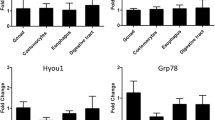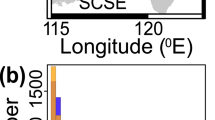Abstract
Temperature is one of the main abiotic factors influencing the distribution and abundance of organisms. In the Rhône River Valley, populations of the crustacean Gammarus pulex are distributed along a 5 °C thermal gradient from the North to the South of the valley. In this present work, we investigated the heat shock response of G. pulex according to latitudinal distribution (northern vs. southern populations) and ontogeny (adults vs. embryos from early stages). We isolated two isoforms (one constitutive hsc70 and one inducible hsp70) of heat shock proteins 70 (HSP70) and quantitatively compared their amounts of mRNA after heat shocks, using real-time PCR. Whereas the hsc70 (constitutive) gene did not vary between the two populations, a significant effect of the population was observed on the expression of the hsp70 (inducible) gene in adult specimens. The northern population of amphipods showed a greater magnitude of induction and a 2 °C lower onset temperature when compared to the southern population, suggesting that the northern population is more affected by elevated temperature than the southern one. We demonstrated that the expression of hsp70 may play a crucial role in the persistence of biogeographical patterns of G. pulex, since it reflects the natural distribution of this species along the latitudinal thermal gradient. A differential regulation of hsc70 gene was also observed according to the ontogenetic stage, with a switch from heat inducible in early life stages to constitutively and highly expressed in adults. These findings demonstrate the importance of considering the entire life cycle to better understand the adaptive response to thermal stress.




Similar content being viewed by others
References
Ali KS, Dorgai L, Abraham M, Hermesz E (2003) Tissue- and stressor-specific differential expression of two hsc70 genes in carp. Biochem Biophys Re Commun 307:503–509
Arkush KD, Cherr GN, Clegg JS (2008) Induced thermotolerance and tissue Hsc70 in juvenile coho salmon Oncorhynchus kisutch. Acta Zool 89(4):331–338
Belén Arias M, Josefina Poupin M, Lardies MA (2011) Plasticity of life-cycle, physiological thermal traits and hsp70 gene expression in an insect along ontogeny: effect of temperature variability. J Therm Biol 36:355–362
Boorstein WR, Ziegelhoffer T, Craig EA (1994) Molecular evolution of the HSP70 multigene family. J Mol Evol 38:1–17
Chown SL (2001) Physiological variation in insects: hierarchical levels and implications. J Insect Physiol 47:649–660
Chuang KH, Ho SH, Song YL (2007) Cloning and expression analysis of heat shock cognate 70 gene promoter in tiger shrimp (Penaeus monodon). Gene 405:10–18
Cottin D, Shillito B, Chertemps T, Thatje S, Léger N, Ravaux J (2010) Comparison of heat-shock responses between the hydrothermal vent shrimp Rimicaris exoculata and the related coastal shrimp Palaemonetes varians. J Exp Mar Biol Ecol 393:9–16
Cottin D, Roussel D, Foucreau N, Hervant F, Piscart C (2012) Disentangling the effects of local and regional factors on the thermal tolerance of freshwater crustaceans. Naturwissenschaften 99:259–264
DiDomenico BJ, Bugaisky GE, Lindquist S (1982) Heat shock and recovery are mediated by different translational mechanisms. Proc Natl Acad Sci USA 79:6135–6181
Dietz TJ, Somero GN (1992) The threshold induction temperature of the 90 kDa heat shock protein is subject to acclimatization in eurythermal goby fishes (genus Gillichthys). Proc Natl Acad Sci USA 89:3389–3393
DiIorio PJ, Holsinger K, Schultz RJ, Hightower LE (1996) Quantitative evidence that both Hsc70 and Hsp70 contribute to thermal adaptation in hybrids of the live bearing fishes Poeciliopsis. Cell Stress Chap 1:139–147
Easterling DR, Meehl GA, Parmesan C, Changnon SA, Karl TR, Mearns LO (2000) Climate extremes: observations, modeling, and impacts. Science 289:2068–2074
Fader SC, Yu Z, Spotila JR (1994) Seasonal variation in heat shock proteins (hsp70) in stream fish under natural conditions. J Therm Biol 19:335–341
Fangue NA, Hofmeister M, Schulte PM (2006) Intraspecific variation in thermal tolerance and heat-shock protein gene expression in common killifish, Fundulus heteroclitus. J Exp Biol 209:2859–2872
Feder ME, Hofmann GE (1999) Heat-shock proteins, molecular chaperones, and the stress response: evolutionary and ecological physiology. Annu Rev Physiol 61:243–282
Foucreau N, Puijalon S, Hervant F, Piscart C (2013) Effect of leaf litter characteristics on leaf conditioning and on consumption by Gammarus pulex. Fresh wat Biol 58:1672–1681
Foucreau N, Cottin D, Piscart C, Hervant F (2014) Physiological and metabolic responses to rising temperature in Gammarus pulex (Crustacea) populations living under continental or Mediterranean climates. Comp Biochem Phys A 168:69–75
Fu W, Zhang F, Liao M, Liu M, Zheng B, Yang H, Zhong M (2013) Molecular cloning and expression analysis of a cytosolic heat shock protein 70 gene from mud crab Scylla serrata. Fish Shell Immunol 34:1306–1314
Geffard O, Xuereb B, Chaumot A, Geffard A, Biagianti S, Noël C, Abbaci K, Garric J, Charmantier G, Charmantier-Daures M (2010) Ovarian cycle and embryonic development in Gammarus fossarum: application for reproductive toxicity assessment. Environ Tox Chem 29(10):2249–2259
Hochahcka PW, Somero GN (2002) Biochemical adaptation: mechanism and process in physiological evolution. Oxford University Press, Oxford
Hofmann GE, Somero GN (1995) Evidence for protein damage atenvironmental temperatures: seasonal changes in levels of ubiquitin conjugates and hsp70 in the intertidal mussel Mytilus trossulus. J Exp Biol 198:1509–1518
Krebs RA, Loeschcke V (1994) Cost and benefits of activation of the heat-shock response in Drosophila melanogaster. Funct Ecol 8:730–737
Leignel V, Cibois M, Moreau B, Chénais B (2007) Identification of new subgroup of HSP70 in Bythograeidae (hydrothermal crabs) and Xanthidae. Gene 396:84–92
Lindquist S, Craig EA (1988) The heat-shock proteins. Annu Rev Genet 22:631–677
Liu J, Yang WJ, Zhu XJ, Karouna-Reinier NK, Rao RK (2004) Molecular cloning and expression of two hsp70 genes in the prawn, Macrobrachium rosenbergii. Cell Stress Chap 9:313–323
Maazouzi C, Piscart C, Legier F, Hervant F (2011) Ecophysiological responses to temperature of the “killer shrimp” Dikerogammarus villosus: is the invader really stronger than the native Gammarus pulex? Comp Biochem Phys A 159:268–274
Moenickes S, Schneider AK, Mülhe L, Rohe L, Richter O, Suhling F (2011) From population-level effects to individual response: modelling temperature dependence in Gammarus pulex. J Exp Biol 214:3678–3687
Parsell DA, Lindquist S (1993) The function of heat-shock proteins in stress tolerance: degradation and reactivation of damaged proteins. Annu Rev Genet 27:437–496
Pinkster S (1972) On members of the Gammarus pulex-group (Crustacea-Amphipoda) from Western Europe. Bijdr Dierk 42:164–191
Piscart C, Mermillod-Blondin F, Maazouzi C, Mérigoux S, Marmonier P (2011) Potential impact of invasive amphipods on leaf litter recycling in aquatic ecosystems. Biol Invasions 13:2861–2868
Pöckl M, Humpesch UH (1990) Intra- and inter-specific variations in egg survival and brood development time for Austrian populations of Gammarus fossarum and Gammarus roeseli (Crustacea: Amphipoda). Freshwat Biol 23:441–455
Pörtner HO, Farrell AP (2008) Physiology and climate change. Science 322:690–692
Prapapanish V, Chen S, Toran EJ, Rimerman RA, Smith DF (1996) Mutational analysis of the hsp70-interacting protein Hip. Mol Cell Biol 16:6200–6207
Ravaux J, Toullec JY, Léger N, Lopez P, Gaill F, Shillito B (2007) First hsp70 from two hydrothermal vent shrimps, Mirocaris fortunata and Rimicaris exoculta: characterization and sequence analysis. Gene 386:162–172
Rhee JS, Raisuddin S, Lee KW, Seo JS, Ki JS, Kim IC (2009) Heat shock protein (Hsp) gene responses of the intertidal copepod Tigriopus japonicus to environmental toxicants. Comp Biochem Physiol C 149:104–112
Sanders BM (1993) Stress proteins in aquatic organisms: an environmental perspective. Crit Rev Toxicol 23:49–75
Somero GN (2002) Thermal physiology and vertical zonation of intertidal animals: optima, limits, and costs of living. Integr Comp Biol 42:780–789
Somero GN (2010) The physiology of climate change: how potentials for acclimatization and genetic adaptation will determine “winners” and “losers”. J Exp Biol 213:912–920
Sørensen JG, Kristensen TN, Loeschcke V (2003) The evolutionary and ecological role of heat shock proteins. Ecol Lett 6:1025–1037
Sorte CJB, Hofmann G (2004) Changes in latitudes, changes in aptitudes: Nucella canaliculata (Mollusca: Gastropoda) is more stressed at its range edge. Mar Ecol Prog Ser 274:263–268
Stillman JH (2002) Causes and consequences of thermal tolerance limits in rocky intertidal porcelain crabs, genus Petrolisthes. Integr Comp Biol 42:790–796
Stillman JH, Somero GN (2000) A comparative analysis of the upper thermal tolerance limits of eastern Pacific porcelain crabs, Genus Petrolisthes: influence of latitude, vertical zonation, acclimation and phylogeny. Physiol Biochem Zool 73:200–208
Sutcliffe DW, Carrick TR, Willoughby LG (1981) Effects of diet, body size, age and temperature on growth rates in the amphipod Gammarus pulex. Freshwat Biol 11:183–214
Tomanek L (2010) Variation in the heat shock response and its implication for predicting the effect of global climate change on species’ biogeographical distribution range and metabolic costs. J Exp Biol 213:971–979
Tomanek L, Somero GN (1999) Evolutionary and acclimation-induced variation in the heat-shock responses of congeneric marine snails (genus Tegula) from different thermal habitats: implications for limits of thermotolerance and biogeography. J Exp Biol 202:2925–2936
Welton JS, Clarke RT (1980) Laboratory studies on the reproduction and growth of the amphipod, Gammarus pulex (L.). J Anim Ecol 49:581–592
Whiteley NM, Rastrick SPS, Lunt DH, Rock J (2011) Latitudinal variations in the physiology of marine gammarid amphipods. J Exp Mar Biol Ecol 400:70–77
Wu R, Sun Y, Lei LM, Xie ST (2008) Molecular identification and expression of heat shock cognate (HSC70) in the pacific white shrimp Litopenaeus vannamei. Mol Biol 42(2):265–274
Acknowledgments
We are grateful to Sarah Dalmais, Kathleen Ferrand and Marion Genevois for their help in sampling and experimental work. We also thank Samuel Bornens for his support in quantitative real-time PCR analysis at the University Pierre et Marie Curie. This work was funded through a research grant, the WETCHANGE project (2010–2012, grant n° ANR-09-CEP-006-01), of the CEP 2009 program of the National Research Agency (ANR).
Author information
Authors and Affiliations
Corresponding author
Additional information
Communicated by G. Heldmaier.
Rights and permissions
About this article
Cite this article
Cottin, D., Foucreau, N., Hervant, F. et al. Differential regulation of hsp70 genes in the freshwater key species Gammarus pulex (Crustacea, Amphipoda) exposed to thermal stress: effects of latitude and ontogeny. J Comp Physiol B 185, 303–313 (2015). https://doi.org/10.1007/s00360-014-0885-1
Received:
Revised:
Accepted:
Published:
Issue Date:
DOI: https://doi.org/10.1007/s00360-014-0885-1




